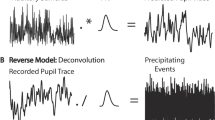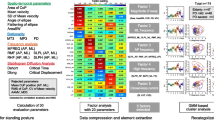Abstract.
Human quiet standing is often modeled as a single inverted pendulum rotating around the ankle joint, under the assumption that movement around the hip joint is quite small. However, several recent studies have shown that movement around the hip joint can play a significant role in the efficient maintenance of the center of body mass (COM) above the support area. The aim of this study was to investigate how coordination between the hip and ankle joints is controlled during human quiet standing. Subjects stood quietly for 30 s with their eyes either opened (EO) or closed (EC), and we measured subtle angular displacements around the ankle (θ a ) and hip (θ h ) joints using three highly sensitive CCD laser displacement sensors. Reliable data were obtained for both angular displacement and angular velocity (the first derivative of the angular displacement). Further, measurement error was not predominant, even among the angular acceleration data, which were obtained by taking the second derivative of the angular displacement. The angular displacement, velocity, and acceleration of the hip were found to be significantly greater (P<0.001) than those of the ankle, confirming that hip-joint motion cannot be ignored, even during quiet standing. We also found that a consistent reciprocal relationship exists between the angular accelerations of the hip and ankle joints, namely positive or negative angular acceleration of ankle joint is compensated for by oppositely directed angular acceleration of the hip joint. Principal component analysis revealed that this relationship can be expressed as: \(\ddot \theta _h = \gamma \ddot \theta _a \) with γ=–3.15±1.24 and γ=–3.12±1.46 (mean ±SD) for EO and EC, respectively, where '\(\ddot \theta \) ' is the angular acceleration. There was no significant difference in the values of γ for EO and EC, and these values were in agreement with the theoretical value calculated assuming the acceleration of COM was zero. On the other hand, such a consistent relationship was never observed for angular displacement itself. These results suggest that the angular motions around the hip and ankle joints are not to keep the COM at a constant position, but rather to minimize acceleration of the COM.
Similar content being viewed by others
Author information
Authors and Affiliations
Additional information
Electronic Publication
Rights and permissions
About this article
Cite this article
Aramaki, Y., Nozaki, D., Masani, K. et al. Reciprocal angular acceleration of the ankle and hip joints during quiet standing in humans. Exp Brain Res 136, 463–473 (2001). https://doi.org/10.1007/s002210000603
Received:
Accepted:
Issue Date:
DOI: https://doi.org/10.1007/s002210000603




